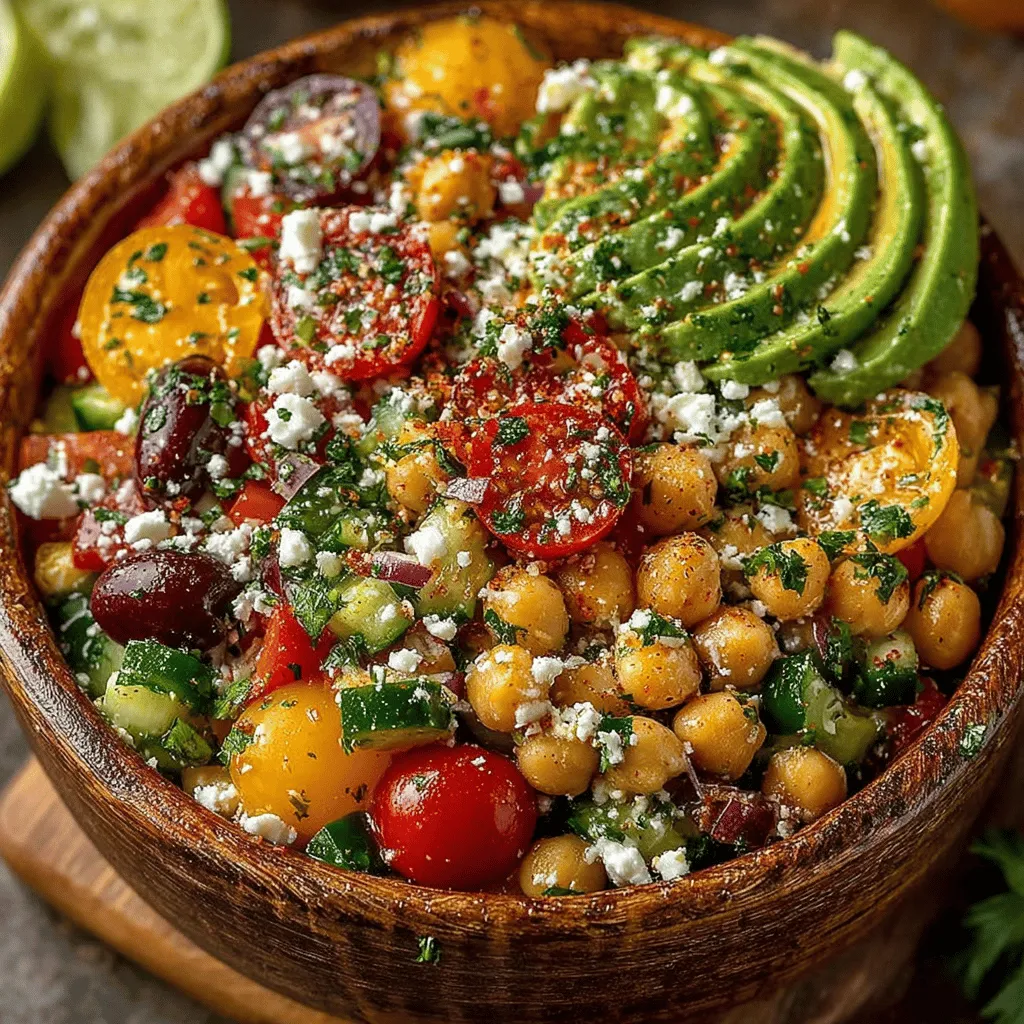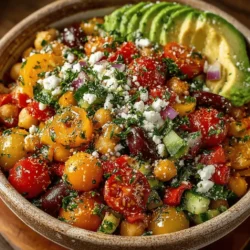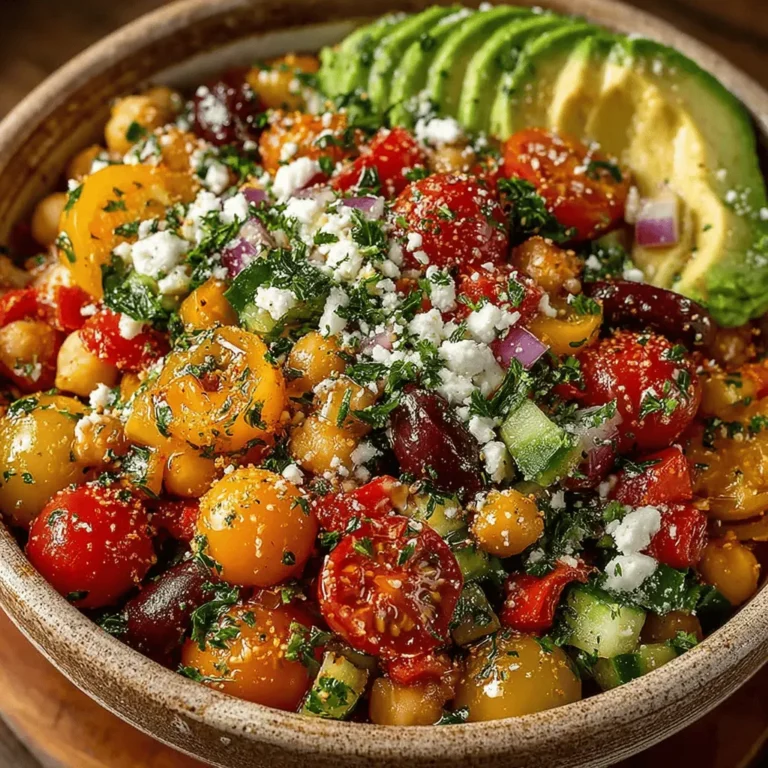Mediterranean Chickpea Salad Bowls: A Fresh and Nutritious Delight
The Mediterranean diet has long been celebrated for its emphasis on whole foods, healthy fats, and vibrant flavors. Rooted in the culinary traditions of countries bordering the Mediterranean Sea, this diet is rich in fruits, vegetables, whole grains, legumes, and healthy fats, particularly olive oil. Research has shown that following a Mediterranean diet can lead to numerous health benefits, including reduced risk of heart disease, improved brain health, and better weight management. With its focus on fresh, natural ingredients, it’s no wonder that more people are turning to Mediterranean-inspired dishes for both nourishment and enjoyment.
One such dish that encapsulates the essence of this diet is the Mediterranean Chickpea Salad Bowl. This recipe is a delightful medley of flavors and textures, showcasing the wholesome goodness of chickpeas alongside a colorful array of fresh vegetables. Packed with nutrients, this salad is not only a feast for the eyes but also a powerhouse of health benefits, making it an ideal choice for anyone seeking a balanced meal. Whether you’re vegan, vegetarian, or following a gluten-free lifestyle, this salad bowl caters to a variety of dietary preferences, ensuring that everyone can enjoy its deliciousness.
Understanding the Ingredients
To truly appreciate the Mediterranean Chickpea Salad Bowls, it’s essential to understand the key ingredients that bring this dish to life. Each component plays a crucial role in not only enhancing the flavor but also contributing to the nutritional value of the salad.
Chickpeas: At the heart of this salad are chickpeas, also known as garbanzo beans. These legumes are an excellent source of plant-based protein, making them a staple in vegetarian and vegan diets. Additionally, chickpeas are high in fiber, which aids digestion and helps maintain healthy blood sugar levels. Their nutty flavor and firm texture provide a satisfying base for the salad, ensuring it is filling and nutritious.
Fresh Vegetables: The Mediterranean diet is known for its vibrant use of fresh vegetables, and this salad is no exception. Tomatoes, cucumbers, and bell peppers not only add a burst of color but also contribute essential vitamins and minerals. Tomatoes are rich in antioxidants, particularly lycopene, which has been linked to various health benefits, including reduced inflammation. Cucumbers provide hydration and crunch, while bell peppers are loaded with vitamin C and other antioxidants. Together, these vegetables create a refreshing and wholesome salad that embodies the essence of Mediterranean cuisine.
Olives and Feta: A Mediterranean dish wouldn’t be complete without the inclusion of olives and feta cheese. Olives add a salty, briny flavor that enhances the overall taste profile of the salad. Rich in healthy monounsaturated fats, olives are also known for their anti-inflammatory properties. Feta cheese, with its tangy taste and creamy texture, acts as a flavor enhancer, bringing depth to the dish. For those following a vegan diet, the feta can be easily substituted with a plant-based alternative or omitted entirely without compromising the salad’s integrity.
Herbs: Fresh herbs are a hallmark of Mediterranean cooking, and in this salad, parsley and mint take center stage. Parsley is not only a garnish but also a nutrient-rich herb that offers vitamins A, C, and K, along with a variety of antioxidants. Mint adds a refreshing element, elevating the dish and providing a cooling contrast to the other ingredients. The combination of these herbs adds brightness and complexity to the salad, making it a truly flavorful experience.
Dressing Components: To tie all these ingredients together, a simple yet flavorful dressing is essential. The primary components of the dressing are high-quality olive oil, fresh lemon juice, and dried oregano. Olive oil is known for its heart-healthy fats and anti-inflammatory properties, while lemon juice adds a zesty brightness that complements the other flavors. Oregano, a staple herb in Mediterranean cooking, not only enhances the dressing but also provides additional health benefits, including antimicrobial properties. Together, these dressing ingredients create a harmonious blend that elevates the entire salad.
Preparation Steps for Mediterranean Chickpea Salad Bowls
Now that we’ve explored the ingredients that make up the Mediterranean Chickpea Salad Bowls, let’s delve into the preparation process. This salad is not only easy to assemble but also allows for flexibility in terms of ingredient choice, making it an ideal option for meal prep or a quick weeknight dinner.
Step 1: Prepare the Base Ingredients
Start by rinsing and draining a can of chickpeas, or if you prefer, you can use dried chickpeas that have been soaked and cooked. The canned variety is convenient and saves time, but dried chickpeas can offer a firmer texture. Once the chickpeas are ready, place them in a large mixing bowl.
Next, chop your fresh vegetables. Dice ripe tomatoes, slice crisp cucumbers, and finely chop bell peppers. Aim for a uniform size to ensure even mixing and presentation. The combination of these vegetables not only adds flavor but also provides a rainbow of nutrients, making your salad both appealing and healthful.
Step 2: Gentle Mixing
Once your base ingredients are prepared, it’s important to mix them gently. Using a large spoon or spatula, combine the chickpeas and chopped vegetables with care, ensuring that the ingredients are evenly distributed without mashing the chickpeas. This gentle mixing technique helps maintain the texture of the salad and allows each component to shine.
Step 3: Crafting the Dressing
In a separate bowl, whisk together the dressing ingredients. Start with a generous drizzle of olive oil, followed by the juice of fresh lemons. The acidity from the lemon juice will help balance the richness of the olive oil. Add a sprinkle of dried oregano and season with salt and pepper to taste. Whisk until the dressing is well combined and emulsified, creating a smooth texture that will coat the salad evenly.
Step 4: Balancing Flavors
Before adding the dressing to the salad, take a moment to taste it. Adjust the seasoning as needed, adding more lemon juice for acidity or additional herbs for flavor according to your preference. The goal is to create a dressing that enhances the salad’s natural flavors without overpowering them.
Step 5: Assembling the Bowls
Once the dressing is prepared, pour it over the chickpea and vegetable mixture. Gently toss the salad to ensure that every ingredient is coated with the dressing. If you’re looking to impress, consider using a large serving bowl or individual bowls for presentation. Layering the salad allows for an aesthetically pleasing display, showcasing the vibrant colors and textures of the ingredients.
Step 6: Optional Toppings
For an added layer of creaminess, consider including sliced avocado on top of your salad bowls. Avocado not only contributes healthy fats but also enhances the overall texture and flavor profile of the dish. Its rich, buttery consistency can elevate the salad, making it even more satisfying.
As you prepare your Mediterranean Chickpea Salad Bowls, think about how to create a visually appealing presentation. Consider garnishing with additional herbs, a sprinkle of feta cheese, or a few olives on top. A well-presented dish not only looks inviting but also enhances the dining experience, making each bite a joy to savor.
By following these initial preparation steps, you’ll be well on your way to creating a delicious and nutritious Mediterranean Chickpea Salad Bowl that captures the essence of Mediterranean cuisine while catering to a variety of dietary preferences. With its vibrant ingredients and easy assembly, this salad is sure to become a favorite in your culinary repertoire.

Nutritional Analysis
When it comes to healthy eating, the Mediterranean Chickpea Salad Bowl stands out as a champion. Packed with a plethora of nutrients, this vibrant dish not only tantalizes your taste buds but also nourishes your body.
Macronutrient Breakdown
A typical serving of Mediterranean Chickpea Salad contains:
– Proteins: Chickpeas are an excellent plant-based protein source. One cup of cooked chickpeas provides approximately 15 grams of protein, making this salad a great option for vegetarians and vegans. Protein is essential for muscle repair and growth, and it helps keep you feeling full longer.
– Fats: The inclusion of healthy fats from olive oil and avocado is another highlight. A tablespoon of olive oil contains about 14 grams of fat, primarily monounsaturated fats, which are heart-healthy. Avocados contribute about 15 grams of fat per fruit, rich in oleic acid, known for its anti-inflammatory properties.
– Carbohydrates: Chickpeas also provide a good source of complex carbohydrates, with about 45 grams per cup. These carbs are crucial for energy, especially if you’re active. The fiber content in chickpeas (around 12 grams per cup) plays a vital role in digestion and promotes a healthy gut.
Micronutrient Highlights
This salad is not just about macros; it is also a treasure trove of vitamins and minerals:
– Vitamins: The fresh vegetables, like tomatoes, cucumbers, and bell peppers, add a variety of vitamins, including vitamin C (which supports immune function) and vitamin A (essential for vision and skin health).
– Minerals: Chickpeas are rich in iron and magnesium, both of which are essential for energy production and bone health. The salad’s diverse ingredients contribute to a balanced intake of potassium (from avocados) and calcium (from feta cheese, if used).
Benefits of Including Chickpeas
Chickpeas, or garbanzo beans, are a staple in Mediterranean diets, and for good reason. Their high fiber content helps regulate blood sugar levels, making them an excellent choice for those managing diabetes. They also support heart health by lowering cholesterol levels due to their soluble fiber. Additionally, their protein content can assist in muscle building and recovery, making them a perfect option for post-workout meals.
The Role of Healthy Fats
The healthy fats from olive oil and avocado play a crucial role in the overall health benefits of this salad. Monounsaturated fats can help reduce bad cholesterol levels, lowering the risk of heart disease. Moreover, these fats aid in the absorption of fat-soluble vitamins (A, D, E, and K), enhancing the nutritional profile of your meal.
Serving Suggestions and Pairings
To elevate your Mediterranean Chickpea Salad Bowls from a side dish to a complete meal, consider these serving suggestions and pairings:
Suggested Proteins
– Grilled Chicken: Marinate chicken breasts in Mediterranean spices and grill them to perfection. This adds a savory depth to your salad, complementing the chickpeas beautifully.
– Shrimp: Toss shrimp in garlic and lemon, then grill or sauté them for a quick protein boost. The seafood adds a lovely contrast with the salad’s freshness.
– Plant-Based Options: For a vegan protein boost, consider grilled tofu or tempeh. Both options absorb marinades well and add a satisfying texture.
Complementary Sides
To round out your meal, consider serving your salad with:
– Whole Grain Pita: Serve warm whole-grain pita on the side for scooping up the salad, adding a delightful crunch.
– Hummus: A dollop of hummus can enhance the creaminess of the dish while providing extra flavor and protein.
– Tzatziki: This yogurt-based dip adds a refreshing element to the meal, with its cool cucumber and mint flavors.
Seasonal Variations and Adaptations
Embrace the seasons by adapting your Mediterranean Chickpea Salad Bowl:
– Spring: Incorporate fresh asparagus or peas for a vibrant touch.
– Summer: Add ripe peaches or watermelon for a sweet, juicy twist.
– Fall: Roasted butternut squash or Brussels sprouts can bring warmth and depth to the dish.
– Winter: Incorporate hearty greens like kale or roasted root vegetables for a satisfying bowl.
Ingredient Swaps
Feel free to customize your salad based on availability or personal preferences. If you can’t find chickpeas, white beans or lentils can serve as excellent substitutes. Swap feta cheese for a vegan alternative or omit it entirely for a dairy-free option. You can also mix in grains like quinoa or farro for additional texture and flavor.
Cultural Context and Significance
Mediterranean cuisine is renowned for its emphasis on fresh, wholesome ingredients and communal eating. This salad is a perfect reflection of the Mediterranean lifestyle, which celebrates the use of seasonal produce, healthy fats, and lean proteins.
Historical Influences
The ingredients in Mediterranean dishes have been shaped by the diverse cultures surrounding the Mediterranean Sea. From the rich history of olive oil production to the cultivation of chickpeas, these ingredients have long been staples in the diets of people living in this region. The influence of trade and migration has also introduced various spices and flavors, enriching Mediterranean cuisine.
Communal Eating
In Mediterranean culture, food is often a communal experience, meant to be shared among friends and family. This salad embodies that spirit, as it can be easily served in large bowls for gatherings. Sharing meals fosters connection and joy, making the dining experience more memorable.
Essence of Mediterranean Lifestyle
This salad reflects the essence of Mediterranean lifestyle choices, which prioritize health, flavor, and enjoyment. It encourages the consumption of fresh, local produce while promoting a balanced diet filled with variety. By incorporating this salad into your meal planning, you can embrace these principles and enjoy the numerous health benefits that come with them.
Conclusion
The Mediterranean Chickpea Salad Bowl is more than just a meal; it is a celebration of health, flavor, and community. With its rich nutritional profile, this dish offers a balanced mix of proteins, healthy fats, and an array of vitamins and minerals that support overall well-being.
Incorporating this salad into your regular meal planning not only enhances your diet but also introduces you to the vibrant flavors of Mediterranean cuisine. As you experiment with seasonal variations and ingredient swaps, you’ll discover endless possibilities for this versatile dish.
Ultimately, the Mediterranean Chickpea Salad Bowl serves as a reminder of the importance of fresh, wholesome ingredients in everyday cooking. It invites you to enjoy the process of preparing and sharing food while nourishing your body and soul. Embrace the Mediterranean lifestyle, and let this salad inspire your culinary adventures.


